Final Report for ONE14-222
Project Information
Wild blueberries (Vaccinium angustifolium) are a crop with significant cultural and historical significance to the northeast, but are facing considerable competition from Little Bluestem (Schizachyrium scoparius), a weed present throughout Maine and New Hampshire. Due to the nature of most wild blueberry fields (shallow, low fertility, sandy) using conventional herbicides is not a sustainable practice as it can pose a significant risk to local water bodies and drinking water. In the spring of 2014 we tested an organic management option. We added 90% elemental sulfur to randomized plots, measuring 10 by 100 feet each, replicated four times, with a drop spreader. We did this at two sites, in northeastern NH, both with little bluestem present. Our treatments were pH of 4.0 (one time application of 1,000lbs S/acre), pH of 4.5 (one time application of 500lbs S/acre) and pH of 4.0 with 5-4-3 organic fertilizer (one time application of 1,000lbs S, 30lbs N/acre). We monitored the abundance of little bluestem for three seasons, each spring and fall, pulled soil samples from each plot and analyzed leaf tissue during harvest to detect any nutrient deficiencies as a result of the acidic soil.
We were not able to reach the target pH of 4.0 at either study site (4.4 and 4.5 were the lowest achieved at either site, and not in all plots), likely because of the high buffering capacity & high organic matter present at both sites. As a result we did not detect a significant difference in little bluestem size or abundance over time in control or managed plots. Achieving our target pH of 4.0 might have resulted in better control. Additionally, plots that received nitrogen fertilizer with sulfur, had healthier little bluestem plants. The grass responded positively to the fertilizer, even with the addition of sulfur. We conclude that since little bluestem was fairly well established in both of these fields, organic management may no longer be an option. Use of sulfur as an organic control may only be feasible in areas with a small population of the grass, as an early control method. Sulfur should not be considered as the single control method but should be done in conjunction with burning & mowing, hand pulling and herbicide treatment if the weed is well established.
Introduction:
Little bluestem (Schizachyrium scoparius), a weed present in most wild blueberry production fields in western Maine and New Hampshire, can only be managed using a conventional chemical herbicides. With rising demand for organic fruit and conventionally managed fields being transitioned into organic production (Drummond, 2008), the suite of management options for low input or organic growers must be widened. Additionally, global blueberry production is on the rise, causing the price of wild blueberries to fall. In some cases, the cost of production is higher than what a grower can receive from the processor. A more cost effective approach to management must be found for the economic sustainability of blueberry farmers. The primary goal of this research was to explore chemical free management options for little bluestem, and directly answer questions we had been receiving from growers who were interested in organic production. Hexazinone, the active ingredient in Velpar (a common herbicide to control grass in blueberry production) is soluble in water and mobile in the soil. Furthermore, hexazinone should not be applied to rocky outcroppings due to the risk of the direct channel to groundwater. Blueberry fields with rocky outcroppings in Northern New England are not only common but represent the majority of production fields. Reducing the prominent use of this herbicide would be beneficial on many levels.
Research was conducted on two blueberry farms in eastern New Hampshire (Carroll County, NH & Strafford County, NH,) evaluating the efficacy of pH management as a weed suppressant. Sulfur, commonly used to lower the pH of soils in blueberry production, was used as a natural method to suppress growth of little bluestem as identified by Yarborough (2001). This approach is well suited to blueberry production because of the plants natural preference for extremely low soil pH levels.
Our own preliminary studies from 2013 showed suppression of little bluestem with the use of sulfur on a lowbush blueberry field in Strafford County, New Hampshire. One to two ounces of sulfur was applied during the summer months directly to the little bluestem crowns by W. Lord, UNH Cooperative Extension Fruit Specialist and Professor Emeritus. We found decreased prevalence of little bluestem where soil pH was lowered to 4.0 level. This technique could reduce the use of chemical herbicides in lowbush blueberry production. As many blueberry fields are well drained and have low natural fertility and little ability filter nutrients, pesticide runoff is a serious concern. Groundwater and environmental contamination troubles blueberry growers and farming communities alike.
Two on-farm replicated trials were established in spring 2014 at two different low-bush blueberry fields. There was significant weed pressure at both sites. Plots measured 10 feet wide by 100 feet long and replicated 4 times at each site. The four managements were low-pH, medium-pH, low-pH with nitrogen fertilizer, and control. Low-pH plots received the recommended amount of sulfur to reduce soil pH 1.0 unit (low pH) and 0.5 unit (medium pH). Prior to sulfur application, soil samples were taken, and a weed evaluation was done. Weed evaluation was done again each spring and fall. We rated the abundance (1=not severe, 10=very severe) in each plot during the spring and fall.
- Establishment of plots – June 2014
- Application of treatments - June 2014
- Weed evaluations completed
- June 2014 (pre-treatment)
- October 2014
- June 2015
- October 2015
- July 2016
- October 2016 (only site two)
- Post Treatment Soil pH Sampling – July 2014, June 2015, August 2015, July 2016
- Tissue sampling – August 2015, August 2016
We were not able to collect fall weed data from site one in 2016. During data collection, we found the site mowed and many of our field plot markers (flags) destroyed during the process. We were not able to confidently recreate the plots in order to take this last data point. Since we have four data points to base recommendations, we did not feel the loss of this one data point would inhibit the outcome of the project.
Cooperators
Research
A randomized complete block experimental design with plots measuring 10 by 100 feet was implemented to test four treatments. This experiment was conducted on two sites, in Carroll and Strafford counties’ in northeastern New Hampshire. Plots at each site were replicated four times for a total of 16 plots at each site. Management included: pH of 4.0 (one time application of 1,000lbs S/acre), pH of 4.5 (one time application of 500lbs S/acre) and pH of 4.0 with 5-4-3 organic fertilizer (one time application of 1,000lbs S, 30lbs N/acre) and a control (no fertilizer or sulfur). In the spring of 2014, we added 90% elemental sulfur to the randomized plots, with a drop spreader. Plots were designed in a rectangular fashion across the field to allow for the greatest amount of genetic diversity within the blueberry crop. We employed this same experimental design at both sites. The rate of sulfur applied was calculated based on an existing soil pH of 5.0. Applications were made in the spring after snowmelt to reduce runoff risk. Sulfur application are more effective at this time at inhibiting little bluestem as this is the period of rapid growth and uptake.
Prior to spring sulfur application, weed abundance and weed size was recorded from each plot using a 2x2 ft square. We recorded weed number and size 5 times with a 2 foot square in each plot during each evaluation. Our primary measure of change was thru evaluation of little bluestem vigor each spring and fall, over the following 2 seasons. The abundance of little bluestem was recorded for three seasons, each spring and fall. Soil samples were pulled and tested for pH from each plot in the fall of 2015 (year 2) and 2016 (year 3).
During year two and year three, tissue samples were tested (at least 40 leaves from 10-20 plants per plot) during the first week of harvest to assess potential impact from the high rate of sulfur. We used the UNH plant tissue testing program, which provided results on N, P, K, Ca, Mg, Mn, Fe, Cu, B, Al, Zn, Na and S.
We held two winter meetings with the land managers to convey study progress and initial results. In November 2014 we held a meeting with 9 individuals, and provided a year-end report, and in November 2015 we held a meeting with 6 individuals and provided a year-end report. Due to the remote nature of these sites, we did not hold a field meeting at the locations. We wrote a final research report and published it to the UNH Cooperative Extension website for commercial and beginner farmers to use.
Overall, untreated plots had more little bluestem after three years than treated plots, indicating the sulfur did have an effect. However, the sulfur alone did not provide enough control to identify it as an effective management tool to maintain commercial production.
We were not able to reach the target pH of 4.0 at either study site (4.4 and 4.5 was the lowest pH level achieved at either site, and not in all plots), likely because of the high buffering capacity & high organic matter present at both sites. As demonstrated in table one, the change in pH from application date to the end of the study was not one full pH level as desired. The biggest change in pH we achieved was in site two, where the soil pH dropped 0.8-0.6. If we had reached our target pH of 4.0 we might have seen better control. Additionally, in plots that received nitrogen fertilizer with sulfur, we noticed healthier little bluestem plants. The grass responded vigorously to the fertilizer, even with the addition of sulfur.
|
Table 1 Reduction in pH over time (7/2014-7/2016) Plot ID Site one Site two control 1 0 0.1 control 2 0.1 -0.2 control 3 0.1 0.1 control 4 0.2 0.1 low pH 1 0.2 0.5 low pH 2 0.2 0.3 low pH 3 0.1 0.5 low pH 4 0.1 0 Low pH+fertilizer 1 0.3 0.2 Low pH+fertilizer 2 0.2 0.5 Low pH+fertilizer 3 0.3 0.1 Low pH+fertilizer 4 0.2 0.5 medium pH 1 0.1 0.8 medium pH 2 -0.1 0.6 medium pH 3 0.1 0.6 medium pH 4 0.3 0.7 *Negative number indicates a rise in soil pH over time |
Overall, leaf tissue results show more nutrients in the leaf tissue in 2015 than 2016 at both sites. This is likely due to the low rainfall and droughty conditions across the state in 2016. Low levels of leaf nutrients are known to be a result of drought (Hart, 2006). Nitrogen in the leaf tissue was higher in 2015 than 2016 at both sites (graph 1 and 4), possibly due to low rainfall in 2016. We did not detect an increase in leaf tissue nitrogen in the fertilized plots compared with control or sulfur-only plots. It is possible that the added nitrogen was utilized by the grasses and did not have a positive effect on blueberry leaf tissue, since we did note a positive response to the nitrogen fertilizer by the grass. Nitrogen was low, over all treatments, in site two across both years (graph 4).
Research has shown magnesium deficiency is common when soil pH is low, in sandy or in soils with a low Cation Ecxchange Capacity (Havlin et al., 2005). We did not detect a deficiency as a result of the sulfur, but did find lower levels in 2016 versus 2015 (graph 2 and 5). This may be a result of summer drought, or depletion of fertility resources over time. Overall we did not note any discrepancies or deficiencies with leaf tissue tests as a result of the sulfur (graph 3 and 6).

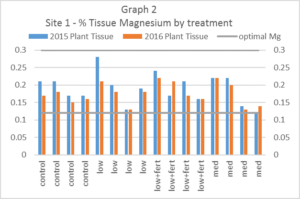

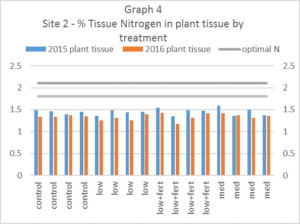
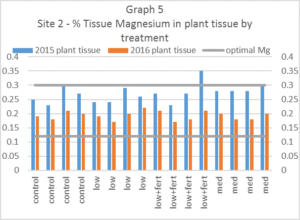
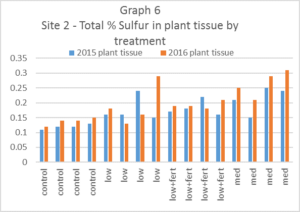
We collected data on little bluestem abundance and average little bluestem size per plot five times at site one and six times at site two. We noticed a general increase in little bluestem size over time, across all treatments at both sites (graph 7 and 8). At site one, there was a pronounced growth in size of little bluestem in the control (no treatment) plots, compared with other treatments (graph 7). Treated plots do trend upwards over time in size of little bluestem, but the growth is not as pronounced as the control plots. The growth in the size of little bluestem in fertilized plots was more similar to the results from control plots than treatments managed for low pH. At site two, we did not detect a difference by treatment in little bluestem size over time. There was not a large difference in little bluestem size by treatment at the last data point, at the end of the study.
Difference in number of little bluestem weeds per treatment was not detected (graph 9 and 10). Some treatments did not have an increase in little bluestem individuals over time, but these treatments were coupled with a larger size of little bluestem, meaning more of the plot area was covered with the grass. At site one, we did note that plots managed for low pH (received the most amount of sulfur) had a similar number of individual little bluestem plants over time, where control plots all increased in number of little bluestem. Site two had a similar positive effect, where control plots had a similar number of little bluestem over time, with low pH plots having lower number of little bluestem over time.
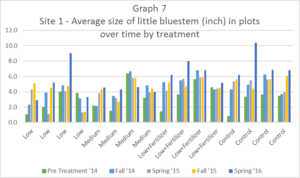
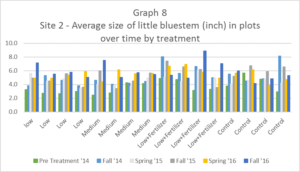
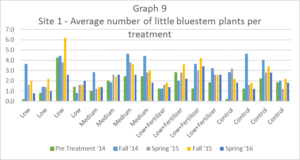
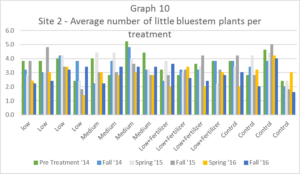
After the final data collection we found both site one and site two to have a higher than acceptable level of little bluestem. Not only did little bluestem colonize each plot, but numerous other weeds like choke cherry, sweet fern, aster, various sedges, moss, and poplar were also becoming a problem over time. Both the landowners and managing growers were not satisfied with the level of control and were considering going back to conventional methods to get the little bluestem under acceptable control. Since little bluestem was fairly well established in both of these fields, organic management may no longer be an option for an acceptable level of control. Use of sulfur as an organic control may only be feasible in areas with a small population of the grass, as an early control method, or as a preventative.
We did detect a small effect from the sulfur, which did slow the growth of the target weed. If we had been able to reach the target pH of 4.0 this effect may have been more pronounced, providing a more acceptable level of control.
Education & outreach activities and participation summary
Participation summary:
As a result of this study, a research report was written and posted to the UNH Extension website. Additionally, this research report was shared via the NH Vegetable and Berry Growers Newsletter (administered thru UNH Extension) with a reach of 577 unique individuals. This research report was also posted to the UNH Cooperative Extension Fruit and Vegetable page.
We held two winter meetings with the land managers to convey study progress and initial results. In November 2014 we held a meeting with 9 individuals, and provided a year-end report, and in November 2015 we held a meeting with 6 individuals and provided a year-end report. These year-end meetings resulted in a change in management of the other blueberry production fields (approx. 15 acres) owned and managed by the landowners.
In late May 2017 we will hold a wild blueberry management meeting for growers, at research site two. We will share the results of the little bluestem study, as well as address management options for other blueberry pests like botrytis, mummy berry, and blueberry maggot.
Project Outcomes
Areas needing additional study
As the price of the wild lowbush blueberry continues to drop, this system of production has become less and less favorable for the commercial grower. New Hampshire has very few commercial lowbush blueberry growers left because the profitability is not suitable for economic sustainability. If we as an agriculture community want to see these systems of production survive we must provide management options and tools to help these growers continue to manage these lands in an environmentally and economically sustainable manner. The cost of sulfur continues to remain low, making it a good option economically for the grower. We should continue to find cost effective ways to manage little bluestem without the use of Hexazinone.
Works Cited
Drummond, Frank, John Smagula, Seanna Annis, and David Yarborough. 2008 "Organic Wild Blueberry Production." University of Maine, Cooperative Extension Bulletin 852. https://extension.umaine.edu/blueberries/factsheets/organic/304-organic-wild-blueberry-production/
Hart, John, Bernadine Strik and Linda White. 2006. Nutrient Management for Blueberries in Oregon. Oregon State University. EM 8918. http://ir.library.oregonstate.edu/xmlui/bitstream/handle/1957/20444/em8918.pdf
Havlin, John; Samuel L. Tisdale; Werner L. Nelson ; James D. Beaton. Soil Fertility and Fertilizers, an introduction to nutrient management. Seventh Edition. Pearson Education/Prentice-Hall, Inc., Upper Saddle River, New Jersey. 2005.
Yarborough, D. 2001. Cultural management for weeds in wild blueberries. University of Maine Cooperative Extension Wild Blueberry Fact Sheet 252. http://www.wildblueberries.maine.edu/PDF/Management/252.pdf